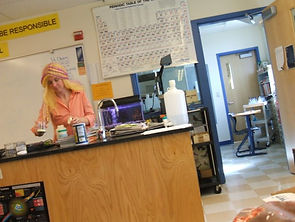
Making learning fun with demonstrations and silliness to model for students my passion for chemistry and for teaching

MISSION STATEMENT
My mission is to inspire all students to be lifelong learners, critical thinkers, and creative problem solvers by creating a classroom learning community that honors the individuality of the students and places value on healthy risk-taking and personal growth. In order to fulfill my mission and manifest my teaching philosophy, I am committed to learning, applying new research-based strategies, and reflecting on my practice.
MY TEACHING PHILOSOPHY
VALUE OF EDUCATION
I believe that education improves a person’s quality of life by providing opportunities for financial success and enriching one’s life with interests and inspirations. Education can guide a person to live a healthier lifestyle. Education helps a person be a responsible and respectful member of a community and of the natural world. By teaching students how to learn, building a love and desire for learning in students, and modeling life-long learning, one can improve students’ lives.
ROLE OF THE EDUCATOR
My goal is to guide students to discover personal knowledge from meaningful experiences. I share with my students my excitement and wonder for the natural world and attempt to arouse their individual curiosities about their world. In this way they may see that science is a part of every aspect of our lives and that there is much to explore in our world. Starting from curiosity, students learn how to apply scientific skills and reasoning to pursue understanding. I aim for my students to strengthen their desire to be learners. Internalizing the motivation to learn increases students’ effort and pride in their work and reinforces a high bar for quality work. I teach with enthusiasm, connecting to prior knowledge and using a variety of approaches and models to make concepts clear, so that each student may successfully reach his or her academic potential. In order to become active and responsible community members, my students consider ways to contribute to improving some aspect of the world.
STRUCTURE OF THE CLASSROOM
The world is our laboratory. I look for what sparks interest in each student, connect the learning experience to his or her personal world, and provide guidance and opportunities to explore these topics. We use the Internet along with first hand laboratory experience to investigate phenomena. Students work collaboratively, using creativity, ingenuity, teamwork, and respect to solve problems together. Students build and use models to explain to others concepts they have tackled. Active student-teacher and student-student discussions help guide the direction of the learning. Each activity is preceded by a clear set of goals and expectations so that students are confident about what they need to do and what the learning environment looks like in the process.
EVIDENCE OF LEARNING
For assessment purposes students regularly reflect on their progress in writings, self and peer assessment rubrics, and parent-student-teacher communications. Lab notebooks are a continuous documentation of students’ work, showing effort and growth. Students write about self-selected readings, work in groups to solve problems, construct models or visual displays of knowledge they have gained, and demonstrate understanding verbally and through movement. Homework and quizzes are used to practice applying new concepts. Tests are designed to show mastery of stills and concepts. Projects, writings and portfolios are utilized to show depth of knowledge. Multiple forms of assessment are used to assess progress toward curricular, classroom and individual goals. The wide array of assessments ensure that students are able to use their strengths in demonstrating their successes.
This video shows a chemical demonstration that several students designed and performed for an AP chemistry independent laboratory project. It is an example of letting curiosity guide learning and letting students discover the world through science. The teacher is the guide and the students are active investigators.

Rafting with students to build relationships and provide adventure learning opportunties that teach healthy risk-taking and learning beyond the classroom walls
